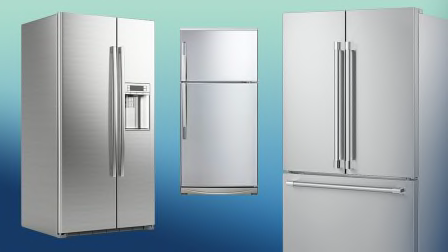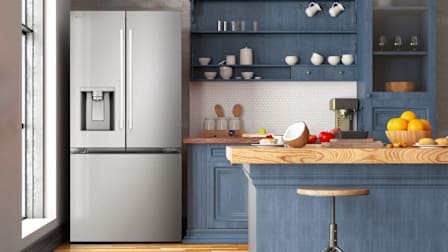Should You Buy a Samsung Bespoke Fridge?
CR’s tests of over a dozen Bespoke refrigerators reveal strong day-to-day performance. But time will tell if they’re more reliable than traditional Samsung French-door and side-by-side models.
When you shop through retailer links on our site, we may earn affiliate commissions. 100% of the fees we collect are used to support our nonprofit mission. Learn more.
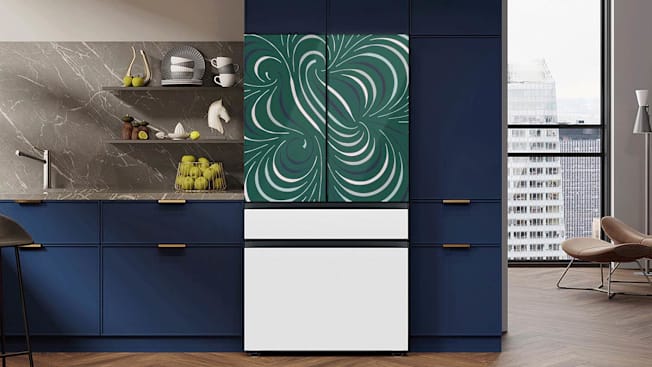
It’s rare to see a new design take off in the world of appliances, but Samsung appears to have created a popular—or at least discussion-worthy—combination of innovations with its Bespoke refrigerators, introduced over the past few years. These fridges allow you to mix and match glass and stainless steel panels in various colors to match your own aesthetic while also providing some new features, such as including two different types of icemakers in the same model.
Should you buy a Bespoke fridge? And if so, which one?
First thing to know: Samsung Bespoke fridges are expensive. They start at $2,300 for the cheapest side-by-side model and climb past $5,000 for the top-of-the-line 4-Door Flex French-door with AI Family Hub+ (more on that mouthful below). It’s not unusual to find a deal that drops the cheapest Bespoke models below $2,000—but for comparison, GE’s similarly high-end Profile line starts at $2,400 and tops out at $4,200 before any discounts.
The 5 Features That Make Samsung Bespoke Fridges Unique
Five big features distinguish Bespoke models from the rest of Samsung’s refrigerators: Bespoke panels, Beverage Center, Dual Ice Makers, Family Hub tablets and smart features, and Samsung AI Vision Inside.
Samsung Bespoke Panels
The biggest draw of Samsung Bespoke refrigerators is their design aesthetic, which comes from the unusual panels that cover the doors. Samsung provides seven glass finishes to choose from (charcoal, clementine, matte gray, morning blue, pink, sunrise yellow, and white), along with four stainless steel finishes (emerald green, matte black, plain stainless steel, and navy).
You can mix and match any of these on Bespoke French-door fridges, whether you choose a three-door, four-door, or 4 Door Flex model. (A four-door model has two French doors at the top of the refrigerator and two pull-out drawers below, while the 4 Door Flex model has two sets of French doors stacked on top of each other.)
Bespoke side-by-sides don’t give you the option to mix and match panels. You can get a Bespoke side-by-side only in white glass or plain stainless steel finishes.
When you buy a Bespoke French-door unaltered from a retailer, the panels will usually all be the same color and finish. If you want to customize the mix of panels before you buy, you can use the Bespoke Design Studio to do so. Otherwise, you can purchase new panels in the colors/finishes you want and swap them out using the Bespoke Suction Cup tool, $30. New panels range from $50 to $150 depending on the panel size. You’ll need three or four of them if you want to change all the panels at once.
To take your design a step further, you can also opt for MyBespoke Custom Panels, which use your own pictures or artwork uploaded to Samsung’s design tool. These panels are also exclusive to Bespoke French-doors and only replace the top panels on the fresh-food compartment doors. The service costs about $300 per panel.
No other manufacturer offers styles similar to the Bespoke fridges. The closest may be LG, which announced its MoodUP refrigerators, which have LED light panels on the doors that can be changed to different color combinations. Those refrigerators have yet to appear at major retailers.
Beverage Center and Dual Ice Makers
Many refrigerators have through-the-door ice and water dispensers, but Bespoke refrigerators forgo these for what the company calls a Beverage Center and Dual Ice Makers.
The Beverage Center is a section on the inside of one of the fresh-food doors that has an AutoFill Water Pitcher with an infuser (to make fruit-infused water) as well as an internal water dispenser. Bespoke French-doors have the Beverage Center inside the left door, while Bespoke side-by-sides have it inside the right door. Some lower-budget Bespoke fridges don’t have the full Beverage Center but do include the AutoFill Water Pitcher.
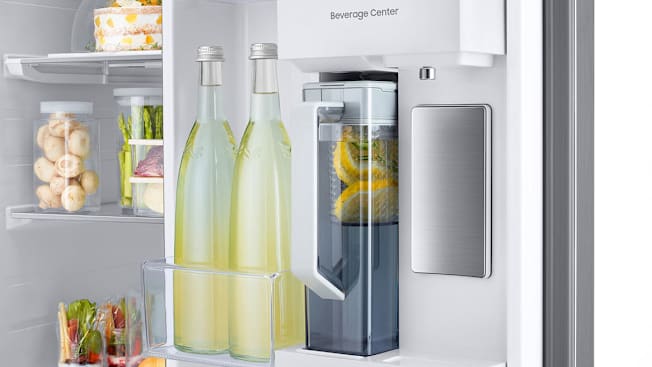
Photo: Samsung Photo: Samsung
The Dual Ice Makers are in the freezer compartment and create two types of ice that are dispensed into their own bins. One icemaker creates large ice cubes, while the other churns out small ice bites, which are similar to the Sonic nugget ice (connoisseurs claim that the bites aren’t as soft and crunchy!) that has a cult following at the fast-food chain. All Bespoke fridges have Dual Ice Makers. In our icemaker performance tests, all but one of the Bespoke models we’ve tested receive midlevel or higher scores.
One note on reliability: Samsung side-by-side refrigerators are particularly prone to icemaker problems, according to CR’s member surveys, while the company’s French-door models stand out for having icemaker and dispenser problems. We don’t have data specific to Bespoke fridges, and while the Beverage Center is essentially a fancy water dispenser, it’s not a through-the-door unit. (See more on the most and least reliable refrigerator brands, including details on Samsung French-door and side-by-side models.)
To be clear, Samsung is not the only company to come up with variations on water/ice dispensers and icemakers. Some GE refrigerators have autofill water pitchers, while many LG refrigerators have two different icemakers (one for cubed or crushed ice, the other for round cocktail-style ice that LG calls Craft Ice). French-doors and side-by-sides made by GE and LG score higher for predicted reliability in CR surveys than their Samsung competitors.
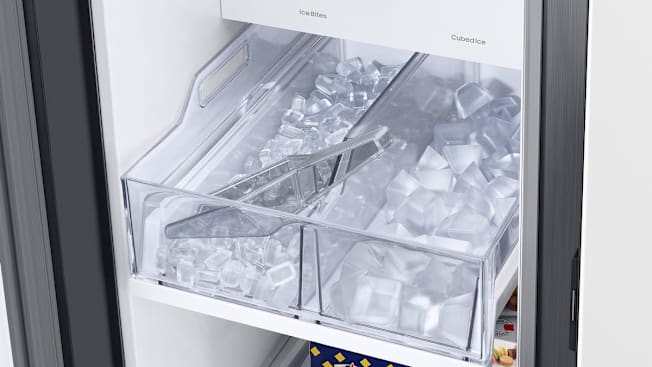
Photo: Samsung Photo: Samsung
Family Hub, Family Hub+, and AI Family Hub+
It’s confusing, but Samsung offers three different versions of its Family Hub tablet and camera system in various Bespoke fridges.
To begin, the plain old Family Hub features a 21.5-inch touchscreen and three internal cameras to let you view the contents of your refrigerator while you’re out shopping. Many popular apps and services are built into the Family Hub tablet, including Amazon Alexa, Google Photos, Instacart, Pandora, Ring (to view Ring doorbell and camera feeds), Samsung TV Plus (to watch free streaming TV channels), and Spotify.
Additionally, the Family Hub can act as a SmartThings smart home hub for devices in your home, including Matter and Thread smart home devices. But to use it that way, you’ll need to buy a SmartThings Hub Dongle, $35, which has an extra wireless radio for devices that use ZigBee and Thread wireless technology.
Next, the Family Hub+ can do everything the regular Family Hub does, but it has a bigger 32-inch touchscreen and the extra smart home hardware is built into it, meaning you can ditch the dongle.
Finally, there’s the AI Family Hub+. It’s essentially the Family Hub+ with extra AI features and a new camera system that enables Samsung’s AI Vision Inside. This new feature uses a single camera mounted at the top of the fresh-food cavity that’s supposed to automatically identify food as you place it inside the refrigerator. You can then view the items on the Family Hub tablet to add expiration dates and look up recipes that use the ingredients you already have. You can also pull up a list of these items on your smartphone, using the SmartThings app, to see what you need while grocery shopping.
The other big feature of the AI Family Hub+ is called AI Energy Mode. This feature is supposed to save energy and money by adjusting the compressor speed and defrost time of the freezer based on how you use the refrigerator.
These Family Hub features can feel gimmicky. But the AI Energy Mode might provide some legitimate savings, and once it’s in your home, a Bespoke refrigerator can get software updates—at least for the first few years.
Samsung says it will provide such updates for seven years, but many people expect to keep a refrigerator for longer than that. Looking back, Samsung added the Amazon Alexa voice assistant to its second-generation and newer Family Hub fridges back in 2021, but the original 2016 Family Hub didn’t receive that update. Similarly, the company announced it will bring AI-generated wallpapers and an AI upgrade for Samsung’s Bixby voice assistant to Family Hub refrigerators—but only to select models. The wallpaper feature is coming to models dating back to 2022, while the Bixby upgrade is only coming to a single 2024 model.
Samsung AI Vision Inside
As mentioned above, Samsung’s AI Vision Inside is only available in Bespoke fridges with AI Family Hub+. We recently tried it out on a Bespoke AI fridge that we got into our labs. We purchased a variety of groceries—including vegetables, fruit, eggs, milk, and packaged items like soda—to see if the refrigerator could identify them.
In our evaluation, it worked about 50 percent of the time. The system generally identified fruits and vegetables correctly, but it struggled with packaged items. We had to make sure the camera at the top of the fridge could see the food as we put it inside, which meant awkwardly holding it up in a way that you normally wouldn’t when putting away groceries.
When the food is correctly identified, the refrigerator adds it to a log and then automatically tags on an expiration date. And if it can’t identify the food, you can still manually add expiration dates. The refrigerator can also detect when an item is removed from it and put back inside, but the fridge didn’t always recognize that an item was removed and then put back inside. As a result, we ended up with a few duplicate entries.
Overall, the concept is cool, and we could see this becoming a useful feature several years from now. But it needs more work, and probably more cameras, to work the way you’d want it to.
FlexZone, WiFi, and Auto Open
These additional features of Bespoke fridges can be appealing to many people, though they aren’t quite as flashy as what’s described above.
FlexZone: A compartment that can convert from fresh-food to freezer storage space and back. It’s available on Bespoke French-door fridges, either as a drawer on four-door models or as the bottom-right compartment on 4 Door Flex models. It’s available on many Samsung refrigerators, not just the Bespoke and Family Hub lines.
WiFi connectivity: All Bespoke refrigerators have WiFi connectivity, allowing you to connect a refrigerator to the Samsung SmartThings app so you can remotely control it and, if it has internal cameras, view the contents of the fresh-food compartment.
Auto Open Door: Some Bespoke fridges have a fresh-food compartment door that automatically pops open when you tap a sensor on the door. It won’t open fully—you still have to pull it all the way open—but the feature makes it easier to open the door if your hands are full of groceries.
CR’s Test Results for Samsung Bespoke Fridges
Here are test results for 12 Bespoke French-door models and two Bespoke side-by-side refrigerators currently on the market. Consumer Reports members can see how they perform in our tests below and click on each model for more detailed information.
How CR Tests Refrigerators
We outfit each refrigerator with 15 temperature sensors in a climate-controlled chamber and monitor it for more than a month, collecting more than 5.4 million temperature readings that identify warm and cold spots, to determine which models will keep your food fresh longest. We evaluate the energy efficiency of each refrigerator and how quietly (or not so quietly) it runs. We test the crisper drawers to see how long they will keep produce fresh, and we measure how much ice the icemaker can produce in a 24-hour period. CR test engineers also judge how easy refrigerators are to use, factoring in a refrigerator’s layout, controls, and lighting.
If you’ve ever felt like your fridge can’t store as much food as you think it should, we’ve got you covered there, too. Our engineers calculate the usable storage space of a refrigerator by measuring each individual shelf, drawer, and bin while subtracting space taken up by icemakers, dispensers, filters, and other parts. We find the total usable storage space is often much less than a fridge’s claimed storage capacity, which is essentially a measurement of the fridge as a big empty box.
In addition to our lab tests, we also factor in annual survey data from tens of thousands of CR members on refrigerators they’ve purchased over the last decade to judge brand reliability and owner satisfaction. All of that—and then some—informs CR’s refrigerator ratings and each model’s Overall Score.
For more information, see how we test refrigerators.





























